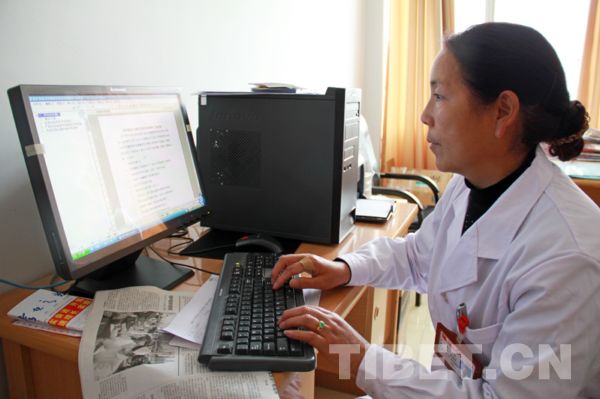
Sadron, as head of the Clinical Laboratory of the Second Tibet People's Hospital works with computer. [Photo/China Tibet Online]
Sadron, as head of the Clinical Laboratory of the Second Tibet People's Hospital and a woman in her middle age, stills maintains her composed, confident, peaceful yet rigorous bearing developed from youth. The woman, who has grown up from an ordinary health worker to an expert in medical testing, is a witness as well as a companion of Tibet's modern health undertaking. Now her major job is to cultivate more medical talents like herself.
From barefoot doctor to clinical laboratory expert
Born into a worker's family in a construction corps, Sadron is particularly eager to learn.
When she was young, she went to the Tibetan language primary school during the daytime, and followed the adults to have Chinese lessons in the evening.
After graduation from the primary school, she grasped the chance and participated in the training for health personnel and barefoot doctors. Thus she paved the way for becoming a doctor.
In 1972, Sadron became one of the four medical personnel on Bayi farm and learned knowledge from manual injection and prescription. At that time, the only training material was the handbook of medical personnel.
"In every busy farming season, we have to go to the countryside to hand out medicines and provide medical treatment for local farmers. But being a barefoot doctor ahd by visiting the households from time to time can only cure some common diseases."
In 1975, Sadron passed the exam of Nanjing Medical College, and went to inland China for the further study. However, Sadron and eight other Tibetan students were transferred to the premed class of Central Academy of National Minorities for lack of basic knowledge. After two years of study, Sadron managed to transfer to study in Jiangsu Zhenjiang Medical College after passing the first National Unified Entrance Examination.
After graduation in 1981, she was assigned to the clinical laboratory in the Tibet Second People's Hospital. At that time, the most pressing need in Tibet was medical experts, so Sadron was assigned the work in clinical laboratory and grasped the skills in half a year.
In 1982, Sadron had the opportunity to study inland about bone marrow cytology and percutaneous needle aspiration biopsy, the most effectual diagnosis of tumor. After that, she started her further study in the General Hospital of Nanjing Military Command, Suzhou, Beijing and Harbin respectively.
Long-term hard work made Sadron famous for diagnosing exotic ailments in Tibet. The fame of her excelsior attitude spread far and wide, bringing lots of patients. She said, "Be responsible for patients and never miss any opportunity to treat them!"
